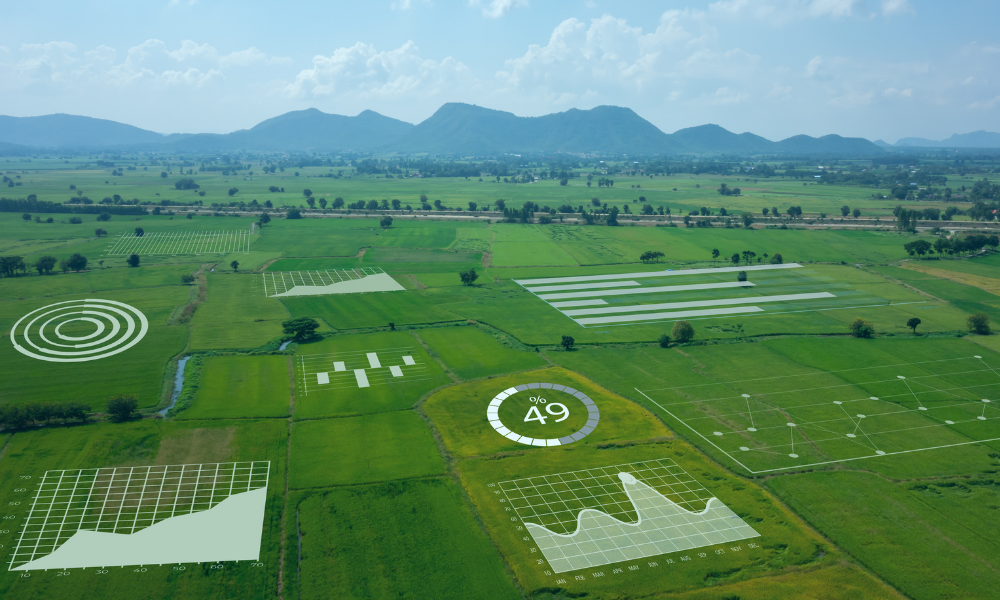The future of Australia’s agriculture is in smart farms.
Australia is the second-largest agricultural area in the world, after China. We have over 85,000 farms using 372 million hectares of land and 9.2 million megalitres of water. In FY 2018-2019, the gross value of Australian agriculture was more than $62 billion. The National Farmers’ Federation has set a daunting vision for that number to reach $100 billion in 2030.
As we’ve seen in the past, mother nature will always throw curveballs. But by connecting the physical world with the digital, you can develop a better understanding of your farm operations to improve efficiencies, drive better decisions, and predict what’s coming next. It is the piece of the puzzle required to move Australia into the future of agriculture while reducing the environmental impact.
If you’re curious about how smart farms and Decision Intelligence will pave the way for growth in agriculture, read on.
What Is A Smart Farm?
Smart farms use the latest technology and data analytics to optimise agricultural practices. Sensors, drones, autonomous vehicles, machinery data and Artificial Intelligence (AI) combine to enhance the overall understanding of operations and identify areas to reduce costs, improve yield and quality, and forecast what’s to come.
One critical tool for smart farms is the Internet of Things (IoT). IoT refers to all of the sensors on the farm that communicate with each other wirelessly via the internet. Using internet connections means farms can be remotely monitored. Equipment, water management, weather events, crop diseases, soil requirements – all of it can be tracked in a dashboard and viewed from any device, anywhere at any time.
Using IoT technology enables automation and more autonomous activities in day-to-day operations. For example, soil sensors track moisture levels and soil health to predict diseases. Drones diagnose crop diseases and measure water and nitrogen levels. Livestock sensors monitor health and fertility. According to KPMG, every farm should be connected to the IoT by 2030. This technology enables total oversight of daily operations, improving operational efficiency without having to be at the physical location or even in the same country!
Lack of internet access is the biggest obstacle for Australia’s agriculture industry to go digital, and the future of farm telecommunications is changing to improve farm connectivity.
“Getting these devices to talk to each other and provide real-time information in a central dashboard at the farmer’s home or office will require connectivity on a scale never seen before, and will undoubtedly involve different interfaces, methods and systems that are not always seamlessly compatible,” says Sami Makelainen, Technology Insights Manager, CTO Strategic Planning and Foresight, Telstra. “The benefits though, once successfully done, will be game changing for Australian farmers.”

Smart Farms + Decision Intelligence = Maximum Impact
Introducing IoT devices into your farm allows you better visibility and management of your operations. With this new technology comes vast volumes of data which, when utilised correctly, can provide additional benefits and insights to your farm operations and profitability. The challenge lies with how to manage these large volumes of data, also referred to as big data. Without a strategy in place, this big data becomes siloed across the different devices with no data relationships and correlation being identified and exploited for their value.
This is where a Decision Intelligence (DI) solution comes in to connect, automate and analyse the data to provide you with actionable insights without being a data scientist. Forget organising and reading reports. Smart farms can operate from one DI dashboard that connects and presents all of the information and insights you need to make the best decisions. The beauty of DI coupled with smart farming is that it removes that risk of building silos of data across your farm which ensures you are always working with the right information on hand.
“Data delivered by digital technology coupled with advanced analytics are a game-changer for Australian farmers to push the boundaries of performance.”
KPMG & National Farmer Federation,
Talking 2030 (2018)
Using IoT technology puts a lot of data at your fingertips, but you also need DI to know what to do with it. Manual handling of data is time-consuming and jeopardises the integrity and reliability of your data. It is too easy to accidentally copy and paste a number incorrectly, throwing off all of your results. DI eliminates the risk of these errors and delivers data-driven insights instead of just data.

The Future of Farming is Now
Smart farms use IoTs to connect every aspect of farming, from soil and crop health to best animal farming practices and weather conditions. Decision Intelligence connects all those IoT devices with any other relevant data sources into one secure location, then analyses and presents that information into an easy to use dashboard.
Farmers don’t have to waste their time analysing reports or stress about whether they are making the right decisions. A DI solution makes it easy by presenting actionable insights for the farmer to make data-driven decisions. The time and resources saved along with continual efficiency enhancements drive higher yields at lower costs.
Smart farming resources are available and are being used now. Toustone has developed a ready-to-implement Agri DI solution to connect all of your data points without the need to change any of your current platforms or devices. If you’re ready to implement smart farming on your farm, get in touch with the team at Toustone today.


